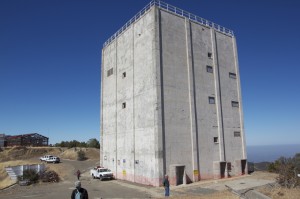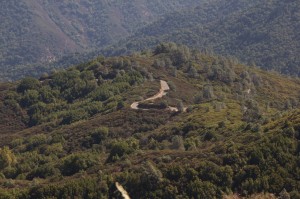Rising 3,486 feet above Los Gatos in the South Bay, Mount Umunhum may well be the tallest mountain you’ve never heard of in the Bay Area.
But the Midpeninsula Regional Open Space District aims to raise its profile to the status of the Bay Area’s other top peaks. Mount Umunhum (Um-un-um), which means “resting place of the hummingbirds” in Ohlone, will at long last be opened to the public for hiking and scenic viewing after more than 50 years in military lockdown.
Midpen is beginning to demolish dozens of old military structures around the summit, a vestige of the Almaden Air Force Station which used the mountain for early warning radar detection during the Cold War. And last week, the Midpen board voted to leave the iconic long- range radar tower at the peak (a.k.a. “the cube”) because of a public outpouring of support for preserving a piece of the mountain’s military past.

“This is the biggest project the district has ever tackled,” said Midpen’s general manager Steve Abbors on a recent media tour of the summit. “It’s really about opening the whole site to the public as a resting area. On a day when you’re socked in the valley with smog so thick you don’t want to breathe, you come up here.”
Mount Umunhum is the fourth highest peak in the Santa Cruz Mountains with a viewshed of 2,000 square miles on a clear day, spanning Monterey Bay to Mount Tamalpais. To get there, you have to wind your way along a gated dirt road through chaparral and bay-oak woodlands in the Sierra Azul Open Space Reserve, a sizable slice of land that Midpen manages along with a smattering of private property owners.
By 2016, the district expects to allow vehicular access to the summit through special permits, and anyone who’s able-bodied will be able to walk to the top on a new 1.7 mile trail that will start at Barlow Road. Once you’re up there, a summit trail will be ADA accessible. General road access won’t happen until the district raises another $3 million for road upgrades.
“That’s a big ticket,” said Gina Coony, the Midpen project planner. “Finding funding for a road is tough. We’re hoping we can find some way to get that done.”
Midpen purchased Mount Umunhum from the federal government in 1986 and it’s taken another quarter-century to acquire $3.2 money in federal funds to complete the toxic cleanup of the site. The military left behind asbestos and lead paint riddled buildings, fuel storage tanks, and PCB-laced transformers, all of which threatened to leach downslope into the watershed.
With that part of the work now done, Midpen is focusing on restoring the site to natural conditions and preparing it for public recreation. The district hopes to eventually provide access for bike riding, horseback riding and hand gliding, in addition to hiking, although the long range plans will require millions of dollars more in fundraising. The overall cost of the entire project is $13 million.

Mount Umunhum is home to 63 unique species, including a population of purple martin, the largest swallow in North America, and the side-blotched lizard, which is not normally known on this side of the Bay, said Abbors. Mountain lions and rattlesnakes are some of the other wildlife highlights. Abbors believes California condors, which have been spotted on neighboring Mount Hamilton, will eventually make their way to Mount Umunhum.
“It’s been disturbed, but nothing much has happened within the last 20 years,” said Abbors. “The mountain has had time to rest and the creatures off the summit will find their way up.”
The radar tower will be virtually the only military structure remaining on the mountain. Last week, the Midpen board set aside $414,000 to seal off and stabilize the concrete block with the hopes that supporters will raise enough money in the next five years to keep it permanent.
On the media tour of the summit, a hummingbird buzzed around a soon-to-be-demolished chain-linked fence next to the radar tower. It was as if the hummingbird had showed up to claim its rightful place at the top of its namesake.
[slideshow]
Alison Hawkes is the online editor at Bay Nature.



-300x221.jpg)
-300x173.jpg)
